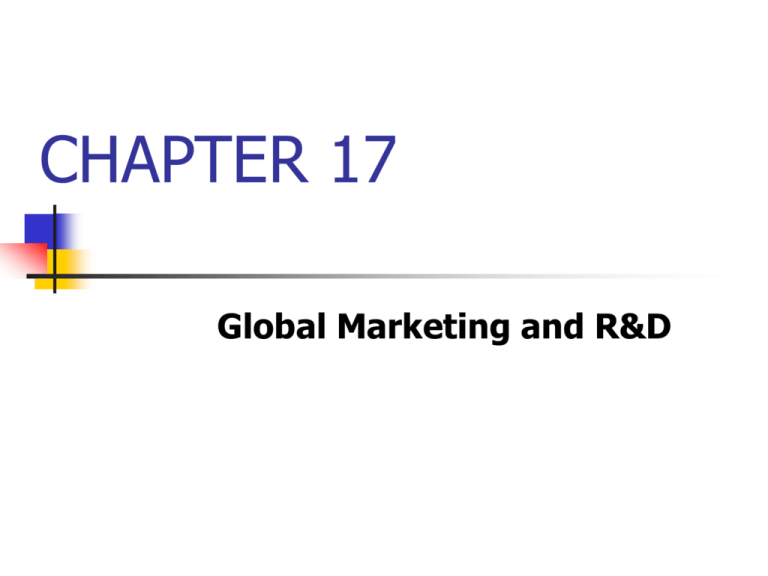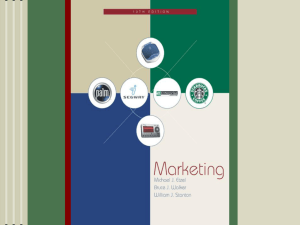
CHAPTER 17
Global Marketing and R&D
17-2
Learning Objectives
McGraw-Hill/Irwin
What are the limits of globalization?
Factors affecting the marketing mix- Four P’s
Why do firms charge two different prices for
the same product? What are the conditions
for successful price discrimination?
Strategic pricing
© 2003 The McGraw-Hill Companies, Inc., All Rights Reserved.
2
17-3
Chapter Focus
McGraw-Hill/Irwin
Examine roles of marketing and R&D in international business.
Reduce costs of value creation.
Add value by better serving customer needs.
Look at the relationship between marketing and R&D.
Look at the marketing mix:
Product attributes.
Set of choices the firm
Distribution strategy.
offers to its targeted
Communication strategy.
market.
Pricing strategy.
© 2003 The McGraw-Hill Companies, Inc., All Rights Reserved.
3
17-4
Globalization of Markets and Brands
“A powerful force drives the world toward a
converging commonalty (sic), and that force is
technology.” Theodore Levitt, Harvard Business
Review.
CNN and MTV.
Overstatement?
Cultural and economic differences act as a major
brake on any trend toward global consumer tastes
and preferences.
McGraw-Hill/Irwin
© 2003 The McGraw-Hill Companies, Inc., All Rights Reserved.
4
17-5
Market Segmentation
geography
Identifying distinct groups of
consumers whose purchasing
behavior differs from other
in important ways.
demographics
Social-cultural
factors
Marketing mix
adjusted to
reflect differing
purchasing
patterns in
segments.
Psychological
factors
McGraw-Hill/Irwin
© 2003 The McGraw-Hill Companies, Inc., All Rights Reserved.
5
17-6
Market Segmentation
Segments that
transcend
national
borders.
McGraw-Hill/Irwin
Two
main
issues
in the
differences
between
countries
Structure of
their market
segments.
© 2003 The McGraw-Hill Companies, Inc., All Rights Reserved.
6
17-7
Product Attributes
Cultural differences.
Economic differences.
Product and technical standards.
McGraw-Hill/Irwin
© 2003 The McGraw-Hill Companies, Inc., All Rights Reserved.
7
17-8
Cultural Differences
McGraw-Hill/Irwin
Range of dimensions:
Social structure.
Language.
Religion.
Education.
Most important - the impact of tradition.
Impact is greatest in foodstuffs and beverages.
Also, scent preferences differ from country to country.
Some tastes and preferences becoming cosmopolitan:
Coffee (Japan and Great Britain).
American-style frozen dinners (Europe).
Levitt’s global culture still a long way off.
© 2003 The McGraw-Hill Companies, Inc., All Rights Reserved.
8
17-9
Economic Differences
Consumer behavior is influenced by economic
development.
Consumers in highly developed countries tend to have
extra performance attributes in their products.
Consumers in less developed countries tend not to
demand these extra performance attributes.
Cars: no air-conditioning, power steering, power
windows, radios and cassette players.
Product reliability is more important.
Contrary to Levitt, consumers in the most developed
countries are often unwilling to sacrifice preferred
attributes for lower prices.
McGraw-Hill/Irwin
© 2003 The McGraw-Hill Companies, Inc., All Rights Reserved.
9
17-10
Product and Technical Standards
McGraw-Hill/Irwin
Government standards can prevent the introduction
of global products.
Different technical standards impede global markets,
as well.
Come from idiosyncratic decisions
made long ago.
Video equipment.
Television signals.
Levitt’s prediction is still far off.
© 2003 The McGraw-Hill Companies, Inc., All Rights Reserved.
10
17-11
Distribution Strategy
Three different distribution systems:
Retail concentration
Channel length.
Channel exclusivity.
Choice of channel:
Cost/benefit of each alternative
vary from country to country.
Longer the channel, the higher the price.
But, cuts selling costs in fragmented market.
Market access.
Shorter channel, lower price.
11
Concentrated market.
McGraw-Hill/Irwin
© 2003 The McGraw-Hill Companies, Inc., All Rights Reserved.
17-12
A Typical Distribution System
Manufacturer
Inside the
Country
Manufacturer
Outside the
Country
Import
Agent
Wholesale
Distributor
Retail
Distributor
Final
Customer
McGraw-Hill/Irwin
Figure 17.1
© 2003 The McGraw-Hill Companies, Inc., All Rights Reserved.
12
17-13
Distribution Can Present Interesting Problems
McGraw-Hill/Irwin
© 2003 The McGraw-Hill Companies, Inc., All Rights Reserved.
13
17-14
Communications Strategy
International communication occurs
When a firm uses a marketing
Message to sell its products in
another country.
McGraw-Hill/Irwin
Channels
direct selling
sales promotion
direct marketing
advertising
© 2003 The McGraw-Hill Companies, Inc., All Rights Reserved.
14
17-15
Communications Strategy
Effectiveness of international communications can be impacted by:
Cultural barriers.
Need to develop cross-cultural literacy.
Source and country of origin effects.
Receiver of the message evaluates it based upon the status
of the sender.
Country of origin effects:
Emphasize/de-emphasize foreign origin.
Noise levels.
Tends to reduce the effectiveness of a message.
Developed countries - high.
Less developed countries - low.
Push versus Pull:
Push emphasizes personal selling.
15
Pull depends on mass media advertising.
McGraw-Hill/Irwin
© 2003 The McGraw-Hill Companies, Inc., All Rights Reserved.
17-16
Attractiveness of Push versus Pull
Strategies
Product Type and
Consumer
Sophistication.
Factors
Channel
Length.
Media
Availability.
McGraw-Hill/Irwin
Pull = selling to large
market segments.
Push = selling
complex products.
Pull = long
distribution channel.
Push = short
distribution channel.
Pull = access to
advertising media.
May be legal
Restrictions.
© 2003 The McGraw-Hill Companies, Inc., All Rights Reserved.
16
17-17
Push-Pull Mix
Push
industrial or
complex
products
McGraw-Hill/Irwin
few print or
electronic media
available
short
distribution
channels
consumer goods
long
distribution
channels
sufficient print
and electronic
media available
Pull
© 2003 The McGraw-Hill Companies, Inc., All Rights Reserved.
17
17-18
Global Advertising
Standardized:
Significant economic advantages.
Scarce creative talent.
Many global brand names.
Non-standardized:
Messages in one country may fail in another.
Advertising regulations can be a restriction.
Dealing with Country differences:
Select some features for standardization and others for
localization.
Saves some costs.
McGraw-Hill/Irwin
© 2003 The McGraw-Hill Companies, Inc., All Rights Reserved.
18
17-19
Advertising in New Delhi
McGraw-Hill/Irwin
© 2003 The McGraw-Hill Companies, Inc., All Rights Reserved.
19
17-20
Pricing Strategy
McGraw-Hill/Irwin
Price discrimination.
Different prices, different
countries, same product.
Strategic pricing.
Regulatory factors:
Price controls.
Antidumping.
© 2003 The McGraw-Hill Companies, Inc., All Rights Reserved.
20
17-21
Pricing Strategy
Price discrimination:
Charging what the market will bear.
Two factors:
Must keep national markets separate
Different price elasticities
Arbitrage:Charging different prices in different countries
for same product.
Doesn’t always work.
Using
Ford in Germany and Belgium
Arbitrage
Sometimes it does.
Ford in UK and Belgium
McGraw-Hill/Irwin
© 2003 The McGraw-Hill Companies, Inc., All Rights Reserved.
21
17-22
Determinants of Demand Elasticity
Income level and competitive
conditions determine elasticity.
McGraw-Hill/Irwin
Elasticity (price) tends to be be greater in
countries with low income levels.
Elasticity (demand) tends to be greater in
countries where there are many
competitors.
© 2003 The McGraw-Hill Companies, Inc., All Rights Reserved.
22
17-23
Elastic and Inelastic Demand Curves
Inelastic
Demand Curve
$
Elastic
Demand Curve
Figure 17.2
Output
McGraw-Hill/Irwin
© 2003 The McGraw-Hill Companies, Inc., All Rights Reserved.
23
Figure 17.3
17-24
Price Discrimination
Revenue
and Costs
Revenue
and Costs
110 -
110 -
100 -
100 -
100 -
80 -
70 -
70 -
70 -
60 -
60 -
60 -
50 -
50 -
40 -
40 -
30 -
20 -
20 -
MR
10 -
McGraw-Hill/Irwin
j+u
50 -
40 -
0
30 -
Output
10 -
50 -
Du
40 -
30 -
20 -
0
MRu
10 -
j
D
40 -
30 -
50 -
Output
40 -
30 -
20 -
0
10 -
10 -
50 -
43.58
D
j
20 -
80 -
Output
MC
MR
j+u
70 -
80 -
30 -
World
90 -
60 -
United
States
90 -
20 -
Japan
90 -
10 -
110 -
Revenue
and Costs
© 2003 The McGraw-Hill Companies, Inc., All Rights Reserved.
17-25
Strategic Pricing
Predatory pricing:
Using price as a competitive weapon.
Multipoint pricing strategy:
When two or more international firms compete against
each other in two or more national markets.
A firm’s pricing strategy in one market may impact a
rival in another market.
Experience curve pricing:
Firms price low worldwide to build market share.
Incurred losses are made up as company moves down
experience curve.
McGraw-Hill/Irwin
© 2003 The McGraw-Hill Companies, Inc., All Rights Reserved.
25
17-26
Regulatory Influences on Prices
Antidumping regulations:
Selling a product for a price that is less than the
cost of producing it.
Predatory pricing and experience curve
pricing may violate regulations.
Antidumping rules place a floor under export
prices and limit a firm’s ability to pursue
strategic pricing.
Competition Policy:
Promote competition.
Restrict monopoly practices.
Can limit the prices a company can charge in a
given country.
McGraw-Hill/Irwin
© 2003 The McGraw-Hill Companies, Inc., All Rights Reserved.
26
17-27
Dumping: GATT and the U.S.
McGraw-Hill/Irwin
GATT:Sale of an imported product at
‘less than fair value’ and causes
‘material injury to a domestic industry’.
US: An unfair trade practice that results
in injury, destruction, or the prevention
of the establishment of an American
industry.
© 2003 The McGraw-Hill Companies, Inc., All Rights Reserved.
27
17-28
Configuring the Marketing Mix
Differences
Here
Culture
Requires
Variation
Here
McGraw-Hill/Irwin
© 2003 The McGraw-Hill Companies, Inc., All Rights Reserved.






